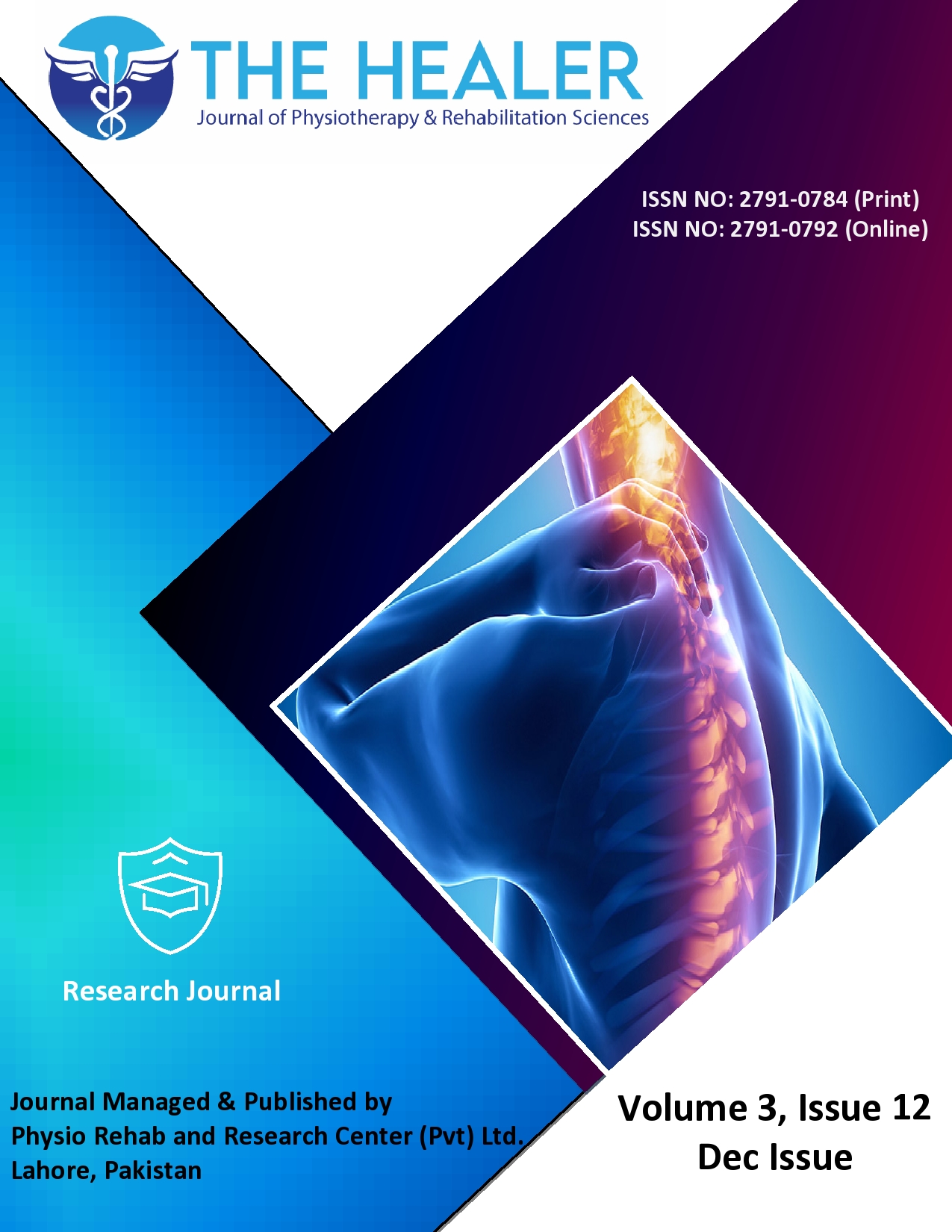Level of Functional Disability in Hockey Players with Turf Toe Using Foot Function Index Questionnaire
Functional Disability in Hockey Players with Turf Toe
DOI:
https://doi.org/10.55735/hjprs.v3i12.267Keywords:
foot function index questionnaire, foot injury, hallux limitus, turf toeAbstract
Background: Turf toe is a hyper-extension injury to the soft tissue of the first or hallux metatarsophalangeal joint. It results in significant functional disability and affect the performance of players in hockey games. Push off, all important in hockey is markedly impaired. To some extent, forward drive and running may also be compromised. Objective: The purpose of the study is to evaluate the level of functional disability in male hockey players with turf toe by using a foot function index questionnaire. Methods: This cross-sectional study was conducted over one hundred and twenty turf toe male patients according to inclusion and exclusion criteria. Non-probability purposive sampling was used to assemble data from various sports complexes in Lahore. Male hockey players aged between 18to 35 years, having turf surface used as playing surface and unilateral turf toe were included The level of function disability was evaluated by Foot Function Index Questionnaire. The data was analyzed through the Statistical Package for Social Science version 20 and that software was also used for the data analysis. The study variables are presented in form of the descriptive statistics (tables, graphs and percentages). Ethical approval was obtained from the ethical committee of the University of Lahore. The questionnaire is accompanied by an information sheet that explains the nature and purpose of the study and describes that the consent was taken by every player. Results: The mean of the functional disability in 120 male hockey players with turf toe was 76.78 and the standard deviation of 23.51162. The level of functional disability related to turf toe was measured with Foot Function Index and it varied from mild to severe. Most of the players with turf toe have moderate functional disability. Conclusion: It was concluded that among 120 participants, most of the adult male hockey players presented with turf toe were lie between 24 to 29 age had moderate disability and were suffering from moderate functional disability. A comparison can be made between the level of functional disability caused by the injury to the first MTP among hockey players playing on a turf field and natural grassy surface.
References
Anderson RB. Turf toe injuries of the hallux metatarsophalangeal joint. Techniques in Foot & Ankle Surgery 2002; 1(2): 102-11.
Kordi R, Hemmati F, Heidarian H, Ziaee V. Comparison of the incidence, nature and cause of injuries sustained on dirt field and artificial turf field by amateur football players. Sports Medicine, Arthroscopy, Rehabilitation, Therapy & Technology 2011; 3(1): 3.
Faltus J, Mullenix K, Moorman III CT, Beatty K, Easley ME. Case series of first metatarsophalangeal joint injuries in division 1 college athletes. Sports health 2014; 6(6): 519-26.
Chou LB. Disorders of the first metatarsophalangeal joint: Diagnosis of great-toe pain. The physician and sportsmedicine 2000; 28(7): 32-45.
George E, Harris AH, Dragoo JL, Hunt KJ. Incidence and risk factors for turf toe injuries in intercollegiate football: data from the national collegiate athletic association injury surveillance system. Foot & ankle international 2014; 35(2): 108-15.
Frimenko RE, Lievers WB, Riley PO, et al. Development of an injury risk function for first metatarsophalangeal joint sprains. Medicine & Science in Sports & Exercise 2013; 45(11): 2144-50.
Bowers KD, Martin RB. Turf-toe: a shoe-surface related football injury. Medicine & Science in Sports & Exercise 1976; 8(2): 81-3.
McCormick JJ, Anderson RB. Turf toe: anatomy, diagnosis, and treatment. Sports Health 2010; 2(6): 487-94.
McCormick JJ, Anderson RB. Rehabilitation following turf toe injury and plantar plate repair. Clinics in sports medicine 2010; 29(2): 313-23.
Drakos MC, Fiore R, Murphy C, DiGiovanni CW. Plantar-plate disruptions:“the severe turf-toe injury.” three cases in contact athletes. Journal of athletic training 2015; 50(5): 553-60.
Lee DK, Mulder GD, Schwartz AK. Hallux, sesamoid, and first metatarsal injuries. Clinics in podiatric medicine and surgery 2011; 28(1): 43-56.
Sahin N, Atici T, Bilgen SM, Bilgen OF. Turf Toe in a Taekwandoo Player: Case Report. Journal of sports science & medicine 2004; 3(2): 96.
Levy IM, Skovron ML, Agel J. Living with artificial grass: A knowledge update: Part 1: Basic science. The American journal of sports medicine 1990; 18(4): 406-12.
Rodeo SA, O'Brien S, Warren RF, Barnes R, Wickiewicz TL, Dillingham MF. Turf-toe: an analysis of metatarsophalangeal joint sprains in professional football players. The American journal of sports medicine 1990; 18(3): 280-5.
Martinez BR, Staboli IM, Kamonseki DH, Budiman-Mak E, Yi LC. Validity and reliability of the Foot Function Index (FFI) questionnaire Brazilian-Portuguese version. Springerplus 2016; 5(1): 1810.
Najefi A-A, Jeyaseelan L, Welck M. Turf toe: a clinical update. EFORT open reviews 2018; 3(9): 501-6.

Downloads
Published
How to Cite
License
Copyright (c) 2024 The Healer Journal of Physiotherapy and Rehabilitation Sciences

This work is licensed under a Creative Commons Attribution 4.0 International License.
CC BY











